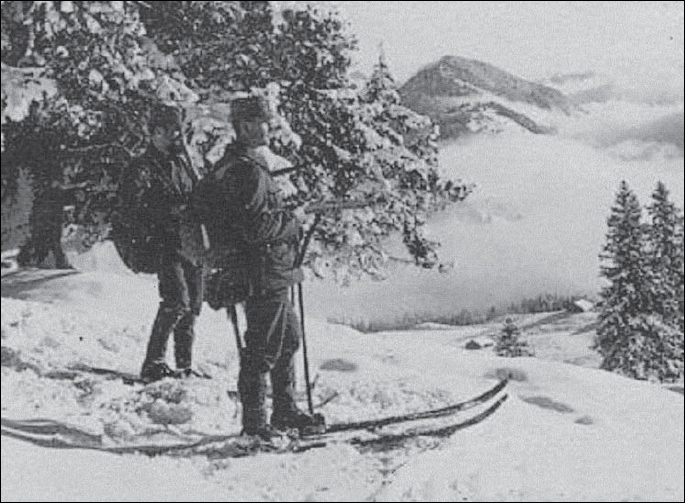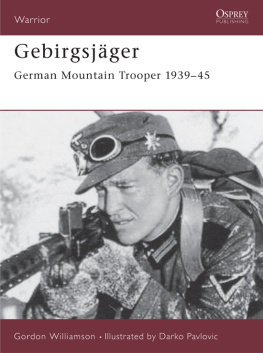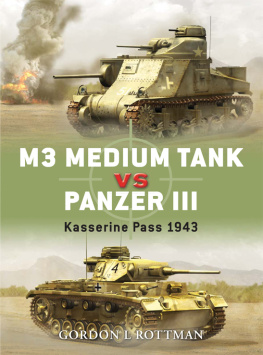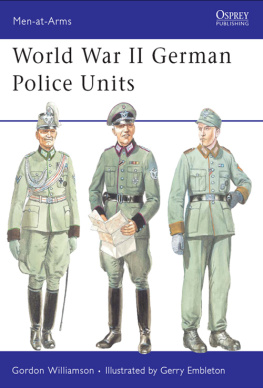Williamson - Gebirgsjager
Here you can read online Williamson - Gebirgsjager full text of the book (entire story) in english for free. Download pdf and epub, get meaning, cover and reviews about this ebook. year: 2012, publisher: Osprey Publishing, genre: Non-fiction. Description of the work, (preface) as well as reviews are available. Best literature library LitArk.com created for fans of good reading and offers a wide selection of genres:
Romance novel
Science fiction
Adventure
Detective
Science
History
Home and family
Prose
Art
Politics
Computer
Non-fiction
Religion
Business
Children
Humor
Choose a favorite category and find really read worthwhile books. Enjoy immersion in the world of imagination, feel the emotions of the characters or learn something new for yourself, make an fascinating discovery.
- Book:Gebirgsjager
- Author:
- Publisher:Osprey Publishing
- Genre:
- Year:2012
- Rating:3 / 5
- Favourites:Add to favourites
- Your mark:
- 60
- 1
- 2
- 3
- 4
- 5
Gebirgsjager: summary, description and annotation
We offer to read an annotation, description, summary or preface (depends on what the author of the book "Gebirgsjager" wrote himself). If you haven't found the necessary information about the book — write in the comments, we will try to find it.
Gebirgsjager — read online for free the complete book (whole text) full work
Below is the text of the book, divided by pages. System saving the place of the last page read, allows you to conveniently read the book "Gebirgsjager" online for free, without having to search again every time where you left off. Put a bookmark, and you can go to the page where you finished reading at any time.
Font size:
Interval:
Bookmark:
German Mountain Trooper 193945

Gordon Williamson Illustrated by Darko Pavlovic
The history of Germanys mountain troops is a fairly short one, such troops being a comparatively recent addition to her armed forces. Mountain warfare in general terms up until the outbreak of World War I had been predominantly related to the suppressing of bandit activity in the high, inaccessible peaks that provided an excellent hiding place for renegades of all kinds. On the outbreak of war in 1914 three countries, Austria, France and Italy, all of whom had troops trained in mountain warfare to protect their Alpine borders (Austria with its mountain Schtzen, Italy with its Alpini troops and France with its Chasseurs Alpins), were drawn into the conflict. Invariably, such units made heavy use of men who were recruited from the localities in which they were to operate and had an intimate knowledge of the terrain.

Mountain troopers from the Imperial German Army in 1915. These soldiers, from 2 Kompanie, 1. Bayerische Schneeschuhbataillon, were the direct forerunners of the Wehrmacht Gebirgsjger. The Bergmtze, trademark of the mountain troops, was closely modelled in the version worn in the Imperial German Army.
Germany at this time had no dedicated alpine troops of its own, but southern Germany had no shortage of men with expert mountaineering abilities and these were soon put to good use in training soldiers in the requisite skills. In 1915, after Austria and Italy had broken off diplomatic relations, the German Armys first mountain unit was formed to assist Austria in the defence of her southern frontier.
This unit, initially only of approximately divisional size, despite the title it was to be given, was known as the Alpenkorps (Alpine Corps) and on 19 May 1915, Generalleutnant Konrad Krafft von Delmensingen, a mountain warfare expert, was appointed as its first commander. Formed at Lech in Bavaria, the Korps units were dispatched to the Austrian South Tyrol on 25 May. The commander in the Tyrol, General der Kavallerie Viktor Dankl had intended to deploy the Korps in the area of BruneckBrixenBozenAuer where it was to be used as a mobile strike force. In the event, however, orders from the German high command on 4 June stipulated that the Alpenkorps must remain on Austrian territory as Germany and Italy were not in a state of war. After some familiarisation and ski training, the Alpenkorps would spend the next five months deployed in Rayon V in support of Feldmarschalleutnant Ludwig Goigingers Pustertal Division.
The new Alpenkorps fought extremely well, one of its most successful commanders being none other than the future Field Marshal Erwin Rommel, who won the coveted Pour le Merite (Blue Max) leading a Wurtemburg Gebirgstruppe unit against the Italians. The skills learned during World War I were not forgotten and Germany maintained and developed its mountain units until they were among the worlds best. The Gebirgsjger quickly attained an elite status that they still hold today. The current German Army retains a small but expertly trained and highly motivated force of Gebirgsjger who still proudly wear the Edelweiss badge of the mountain rifles.
| May 1915 | Alpenkorps created. |
| June 1935 | Gebirgs Brigade created. |
| April 1938 | Gebirgs Division created. |
| August 1939 | 2 Gebirgs Division created around former Austrian soldiers. |
| September 1939 | 1 and 2 Gebirgs Divisions involved in battle of Lemberg. |
| June 1940 | 2 Gebirgs Division victorious at Narvik. |
| March 1941 | 5 Gebirgs Division takes part in the capture of Crete. |
| August 1941 | 1 and 4 Gebirgs Divisions participate in the encirclement of huge Soviet forces at the battle of Uman. |
| June 1942 | The first Waffen-SS mountain troop unit, 6 SS-Gebirgs Division Nord, is formed. |
| July 1942 | 1 and 4 Gebirgs Divisions strike through the Caucasus mountains and by 21 August have planted the German flag on Mount Elbrus, the highest peak. |
| November 1942 | Gebirgsjger Regiment 756 becomes the only mountain troop unit committed to battle in North Africa. |
| November 1943 | 5 Gebirgs Division relieved after 20 months fighting in the swamps of the Volkhov front. |
| June 1944 | Generaloberst Dietl killed in air crash. |
| March 1945 | 1 Gebirgs Division captures Csomend during the final offensive of the war on the Eastern Front, Operation Frhlingserwachsen. |
Following the end of World War I, the Army of the new German Weimar Republic, known as the Reichswehr, was limited by the terms of the Treaty of Versailles to a mere 100,000 men, to be formed into seven infantry and three cavalry divisions.
Almost immediately on taking power, the National Socialists initiated a rapid build-up of the armed forces. Coupled with this there was an explosion in the number of non-military organisations that were used to give covert military training.
Each year some 200300,000 Germans underwent a compulsory period of State Labour Service in the Reichs Arbeits Dienst (RAD). Although much of the service carried out by those serving with the RAD was of a constructional or agricultural nature, it was a uniformed organisation, run on overtly military lines and carried out military-style drill training. Such training may well have involved the carrying of shovels rather than rifles, but the drill movements themselves were clearly intended to impart skills in the handling of weaponry.
Political organisations were also used to teach skills useful to the military. The Partys Flying Corps, the National Sozialistische Flieger Korps (NSFK), was used to give basic flying training and the Motor Corps, or National Sozialistische Kraftfahrkorps (NSKK), gave driver training and instruction on vehicle maintenance.
The Gebirgsjger were represented within the 100,000-man Reichswehr, the mountain units being included in the general expansion of the military when, in 1935, the need for subterfuge to conceal military training ended and universal military conscription was reintroduced.
The state of Bavaria had maintained a core of state police officers trained in mountaineering skills and this group was placed under the command of General Ludwig Kbler. Within two years, the unit had grown in strength to such numbers as merited expansion to Brigade status, and the new Gebirgs Brigade was placed under the command of General Hubert Lanz. This Brigade in turn would form the nucleus of 1 Gebirgs Division.

A fresh batch of enlisted trainees are addressed, with their senior NCO instructors. Note that they do not yet wear the Bergmtze, but the standard Feldmtze worn by all other branches of the armed forces.
In 1938 the annexation of Austria brought a whole new source of skilled mountain soldiers from the former Austrian Army, and these would constitute the core of 2 and 3 Gebirgs Divisions.
Font size:
Interval:
Bookmark:
Similar books «Gebirgsjager»
Look at similar books to Gebirgsjager. We have selected literature similar in name and meaning in the hope of providing readers with more options to find new, interesting, not yet read works.
Discussion, reviews of the book Gebirgsjager and just readers' own opinions. Leave your comments, write what you think about the work, its meaning or the main characters. Specify what exactly you liked and what you didn't like, and why you think so.



















